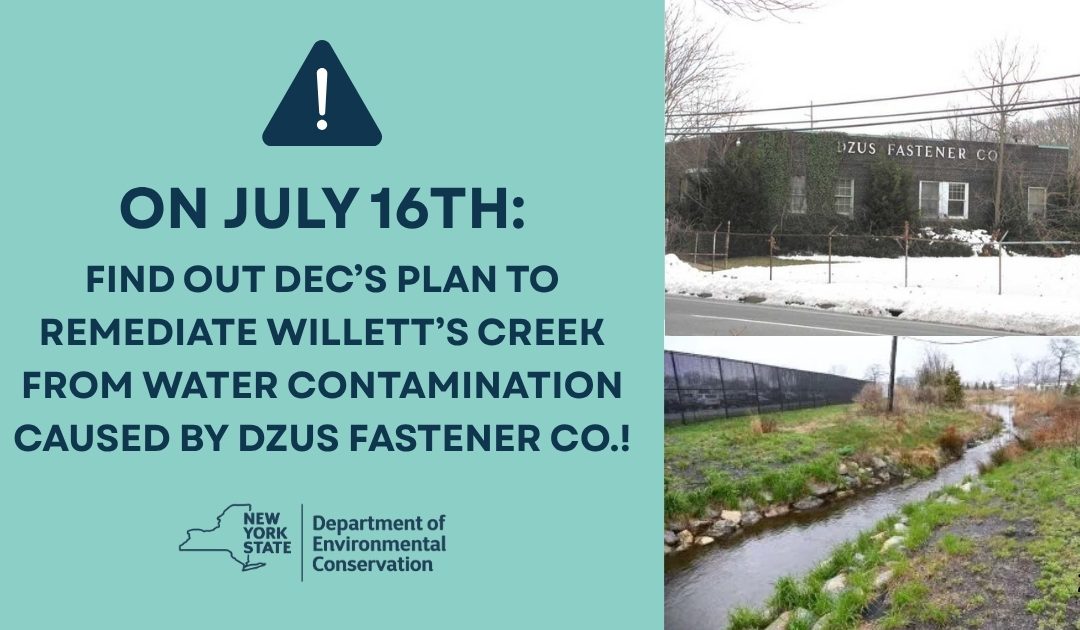For decades, residents of West Islip have lived in the shadow of industrial pollution flowing from the former DZUS Fastener Company site on Union Boulevard. Heavy metals like cadmium and chromium — both known to cause cancer and other serious health issues — have leached into Willetts Creek, making their way into the Great South Bay, one of Long Island’s most cherished and vulnerable waterways.
Now, after years of community advocacy and rising public concern, the New York State Department of Environmental Conservation (DEC) is holding a public meeting to present its proposed Interim Remedial Measure (IRM) — an expedited plan to stop contaminated groundwater from reaching Willetts Creek and the Bay. But the plan addresses only off-site cleanup, and not the toxic source itself at the DZUS site.
📍 Public Meeting Details
-
Date: Wednesday, July 16, 2025
-
Time: 6:00 PM
-
Location: West Islip High School, Cafeteria A/B
-
Address: 1 Lions Path, West Islip, NY 11795
What’s at Stake?
The pollution in Willetts Creek didn’t happen overnight — and it won’t go away without community involvement. For years, Save The Great South Bay and local residents have raised the alarm about contamination originating from the DZUS Superfund site. The factory closed in the 1980s, but its legacy lives on in the soil, groundwater, and downstream ecosystems.
Over $12.6 million has already been spent on cleanup. Yet the problem persists. Toxins are still migrating from the site, threatening marine life, public health, and the long-term vitality of the Great South Bay.
We’re now at a turning point. The DEC is opening a 30-day public comment period from June 30 to July 30, and this July 16 meeting is a rare chance for residents to speak directly with state officials.
The Interim Plan – Necessary but Not Enough
The proposed IRM focuses on off-site measures — preventing the spread of contaminants already moving through the groundwater. But what about the pollution source itself?
To date, the DEC has not published a revised plan to clean up the on-site contamination. Residents have every reason to ask why.
The community deserves a comprehensive, transparent, and enforceable cleanup strategy — one that stops the flow of toxic metals at its source, not just downstream.
Why This Matters for the Great South Bay
Willetts Creek is one of the Great South Bay’s northern tributaries, and its health directly impacts the larger estuary. Once a thriving center of shellfish harvesting, fishing, and boating, the Bay has suffered from nitrogen runoff, habitat loss, stormwater pollution — and now, industrial contamination.
If we want to restore the Bay and protect it for future generations, we must stop toxic groundwater from continuing to flow into our waterways. This is about more than just one site. It’s about defending every creek, every stream, and every drop of water that sustains this ecosystem.
What You Can Do
-
Attend the Meeting: Show up on July 16 to listen, learn, and speak up.
-
Submit Written Comments: Even if you can’t make it in person, written feedback during the public comment period is critical.
-
Share the News: Forward this blog, tell your neighbors, and post on social media. The more voices, the more pressure.
-
Stay Involved: Follow Save the Great South Bay and DEC updates for the next steps.
Accessibility Matters
Interpreter services for the hearing-impaired and for non-English speakers will be available at no charge, but requests must be made in writing by July 2, 2025.
Restoring What’s Been Lost
We can’t undo decades of pollution. But we can stand together to ensure that the mistakes of the past are not ignored — and that real, permanent solutions are pursued.
This is our moment to act.
Join us on July 16. Protect Willets Creek. Save the Great South Bay.

